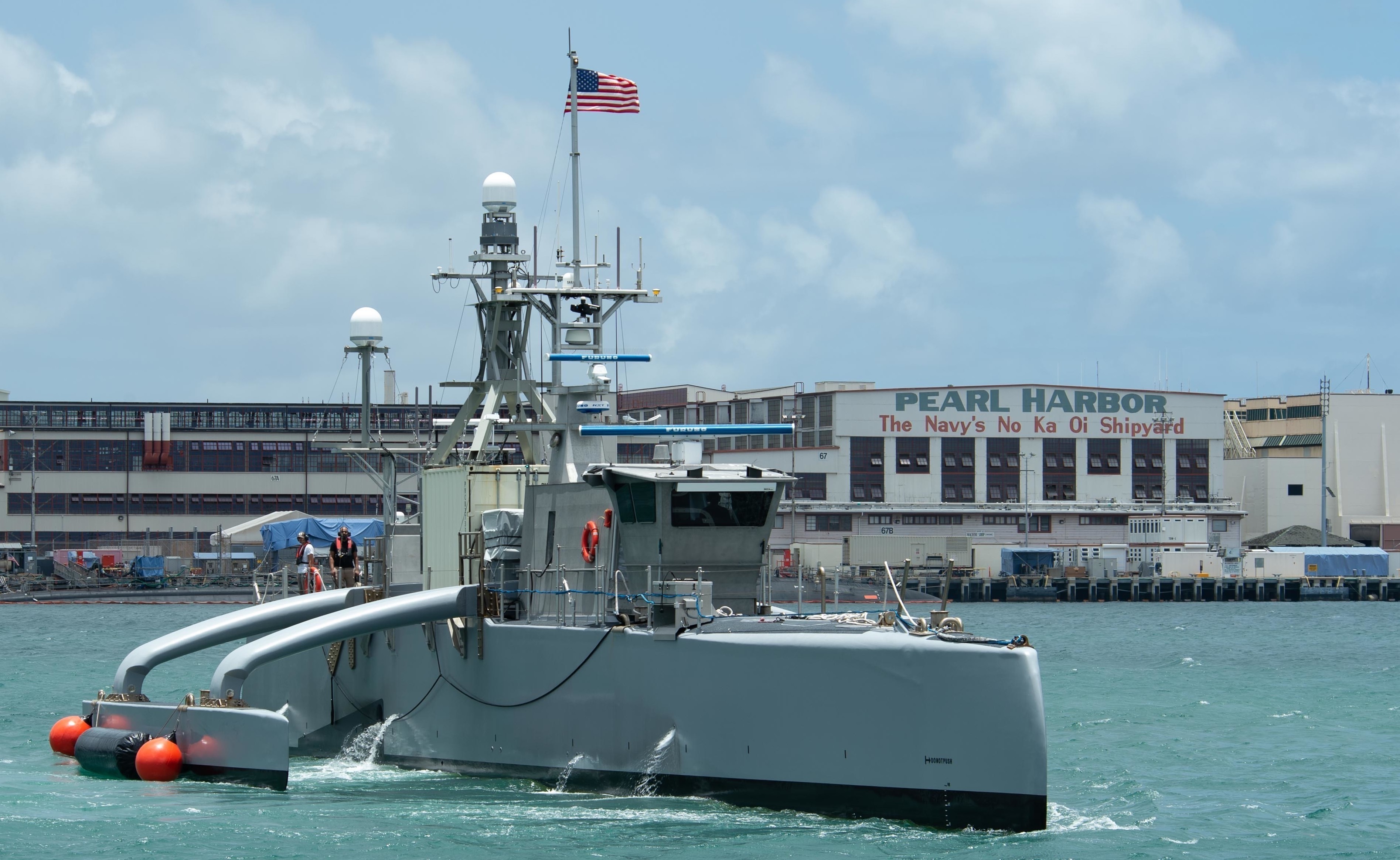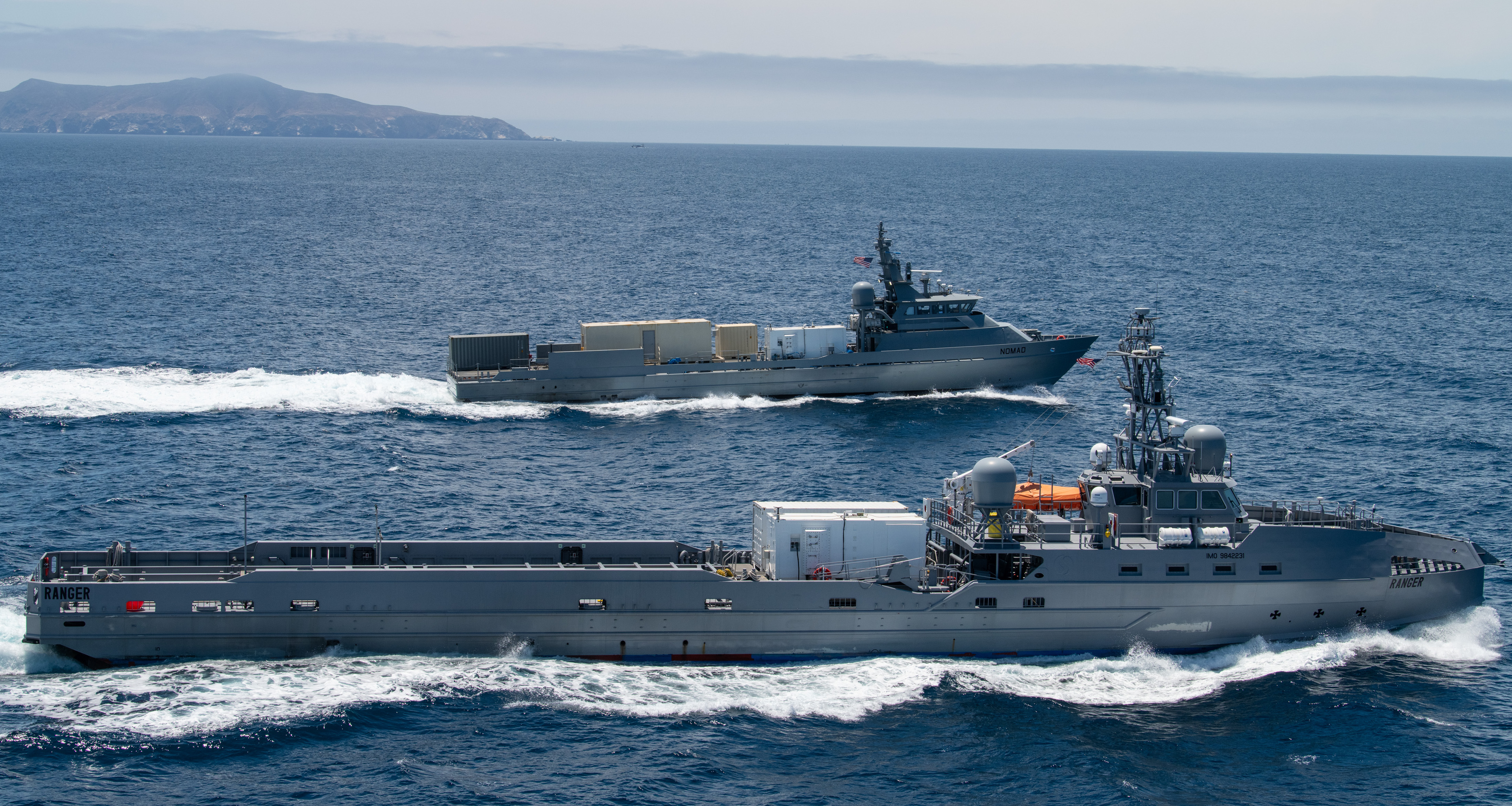
JOINT BASE PEARL HARBOR-HICKAM, HAWAII – With its four experimental unmanned surface vehicles in Hawaii, the Navy is testing news manned-unmanned teaming concepts at the biennial Rim of the Pacific exercise this month.
The service’s two Ghost Fleet Overlord test ships – Nomad and Ranger – are here operating off the coast of Hawaii, along with USV Sea Hunter and USV Sea Hawk, as the Navy continues its research and development efforts to understand how it will employ these unmanned assets. Deploying unmanned systems across the fleet is key to the service’s future force structure.
Cmdr. Jeremiah Daley, the commander of the recently established Unmanned Surface Vessel Division One, said RIMPAC is providing his team the chance to see how the USVs operate in conjunction with manned platforms like cruisers and destroyers.
“We are fully integrated with the entire RIMPAC exercise, both from a planning standpoint, the in-port phase with the sort of final planning pieces, and then the two phases in the underway portion – we are fully integrated with the entire command and control network for all of the manned ships here for RIMPAC,” Daley told USNI News this week at the pier, as Seahawk prepared to leave the harbor for the at-sea phase of the exercise.
Sea Hawk, the last of the USVs to leave the pier for RIMPAC’s at-sea phase, is “directly tied” to Arleigh Burke-class destroyer USS Fitzgerald (DDG-62) in a task group led by the Republic of Singapore Navy, Daley said. That task group is operating under a two-star Korean admiral for the exercise.
“We’re working directly with a destroyer. We’re using different types of sensor payloads to tactically employ the USV from a manned ship. We get all of that data back and all of that feedback back from fleet operators on [cruiser/destroyer] or non-[cruiser/destroyer] ships, depending on the platform. And we’re getting that feedback back while doing the same type of interactions that we would do with regular U.S. forces, we’re doing more and doing it with our coalition partners that are here for RIMPAC,” Daley said.
After some experimentation and exercises with the USVs, Daley said his team took takeaways from those drills and used them to plan for RIMPAC. For example, there is a detachment aboard Fitzgerald operating the USV from the destroyer.
“I have an embarked detachment onboard Fitzgerald that is primarily responsible for controlling the vessels, but they’re also surface warfare officers that are working directly with the technical and the tactical groups onboard Fitzgerald to learn more lessons, right. And if we do those types of events more frequently we’ll get data back … more direct feedback in a faster way vice doing them separate and trying to combine them after.”

Sea Hunter, which was originally developed by the Defense Advanced Research Projects Agency (DARPA), is teaming up with USS William P. Lawrence (DDG-110). Sea Hunter has an electronic warfare payload, while Sea Hawk is operating with a towed array sonar as a sensing payload.
The idea is to use the USVs to augment the sensors aboard the manned destroyers. The USVs are “working directly with the manned platform and their capabilities to bring additional sensing capabilities and distributed sensing capability, which increases lethality from a targeting standpoint, and counter-targeting capability for an adversary if they were trying to find out which ship is doing what – we have four ships out there, as an example, and one of them just happens to be manned,” Daley explained.
Nomad and Ranger will operate with various assets during the exercise, but they are also teaming up with William P. Lawrence. Lawrence is operating under a New Zealand officer at the O-6 level who is the sea combat commander. That officer is embarked on U.S. Ticonderoga-class guided-missile cruiser USS Mobile Bay (CG-53), Daley said.
“We’re connecting our networks in a way that is even one step beyond just manned and unmanned, right. It’s manned and unmanned and collation partners working together,” he told USNI News.
The two Ghost Fleet USVs, which were developed by the Department of Defense’s Strategic Capabilities Office, will have personnel aboard during the exercise. But Sea Hunter and Sea Hawk will operate autonomously without anyone aboard, aside from a small crew that helps the USVs pull away from port. The crew comes off Sea Hunter and Sea Hawk once they head out to sea.
The experimentation at RIMPAC comes as the Navy works to refine both requirements and concept of operations for a future fleet of USVs. Service officials have described the manned-unmanned teaming concept as central to how the service plans to employ the newer technology and integrate it into the fleet.
Sea Hunter delivered to the Navy in early 2021 to attach to the service’s Surface Development Squadron One based in California. Several months later, Nomad reached California after sailing 4,421 nautical miles from the Gulf Coast in a trip the Pentagon described as “98 percent” autonomous.





